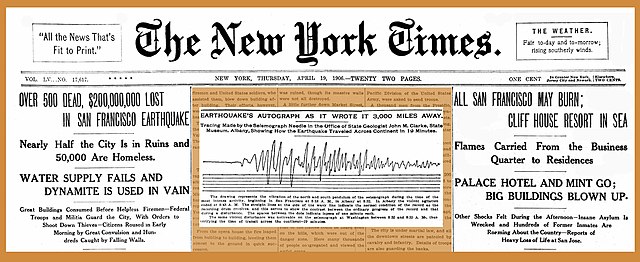Andrew Cowper Lawson was a Scots-born Canadian geologist who became professor of geology at the University of California, Berkeley. He was the editor and co-author of the 1908 report on the 1906 San Francisco earthquake which became known as the "Lawson Report". He was also the first person to identify and name the San Andreas Fault in 1895, and after the 1906 quake, the first to delineate the entire length of the San Andreas Fault which previously had been noted only in the San Francisco Bay Area. He also named the Franciscan Complex after the Franciscan Order of the Catholic church whose missions used conscripted Native American labor to mine limestone in these areas.
Lawson c. 1922
1906 San Francisco earthquake
At 05:12 Pacific Standard Time on Wednesday, April 18, 1906, the coast of Northern California was struck by a major earthquake with an estimated moment magnitude of 7.9 and a maximum Mercalli intensity of XI (Extreme). High-intensity shaking was felt from Eureka on the North Coast to the Salinas Valley, an agricultural region to the south of the San Francisco Bay Area. Devastating fires soon broke out in San Francisco and lasted for several days. More than 3,000 people died, and over 80% of the city was destroyed. The event is remembered as the deadliest earthquake in the history of the United States. The death toll remains the greatest loss of life from a natural disaster in California's history and high on the lists of American disasters.
Ruins in the vicinity of Post and Grant Avenue
Damaged houses on Howard Street
Seismographs on the U.S. east coast recorded the earthquake some 19 minutes later; some early death estimates exceeded 500.
Arnold Genthe's photograph, looking toward the fire on Sacramento Street





